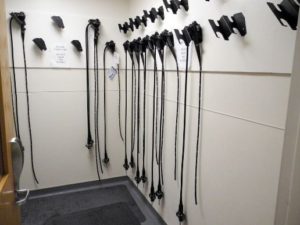 There has been a lot of discussion lately about the number of days a flexible endoscope can safely be in storage before another cleaning is required. Different medical societies like SGNA, ASGE, AORN and APIC have come out with guidance on what the appropriate hang-time limits are. Some hospitals that we’ve talked to have listened to the guidance and set hang-time limits ranging from 7 to 30 days, with many landing right in the middle at 2 weeks. Other hospitals haven’t set a limit, pointing to studies showing that there is no evidence a re-cleaning is required after 30 days and trusting that their scopes will get washed with regularity anyway during the normal course of business.
There has been a lot of discussion lately about the number of days a flexible endoscope can safely be in storage before another cleaning is required. Different medical societies like SGNA, ASGE, AORN and APIC have come out with guidance on what the appropriate hang-time limits are. Some hospitals that we’ve talked to have listened to the guidance and set hang-time limits ranging from 7 to 30 days, with many landing right in the middle at 2 weeks. Other hospitals haven’t set a limit, pointing to studies showing that there is no evidence a re-cleaning is required after 30 days and trusting that their scopes will get washed with regularity anyway during the normal course of business.
While the number of days between re-washes is being debated, staff are still stuck with the laborious task of making sure all of their scopes are re-washed within their hospital’s designated limit.
The issues with today’s process for tracking scope hang-time
A majority of the hospitals we’ve spoken with track their endoscopes’ hang-time in one of two ways:
- Placing paper tags on their scope that list the last date of re-wash and/or the date of the next required re-wash.
- Keeping a log book that shows the last re-wash date of all the scopes under management.
The potential issues that these tracking methods present are numerous.
1. Time is money
Having staff roaming the halls daily to check all the tags on each of your endoscopes seems to be the standard way hospitals monitor their endoscopes to see if they’ve reached their storage limit. Just 10 to 15 minutes spent doing this per day is the equivalent of 1-1.5 weeks spent per year monitoring this information. This is a conservative estimate, which will significantly underestimate the time needed for larger medical centers that have scopes distributed across multiple departments, floors and buildings. This makes the cost of manually tracking scope hang time head in to the tens of thousands of dollars per year.
2. Paper = Non-sterile
The minute you attach a paper tag to a reprocessed scope, you are putting a non-sterile object on your high-level disinfected or sterilized scope. Whenever someone checks a tag, they put their hands on the tag, and that tag in turn touches your scope. Whatever germs that were on the employee’s hand may have transferred on to the supposedly disinfected scope, so the risks are self-evident.
3. Surveyors don’t like it
We have heard stories about surveyors from agencies like TJC who have had issues with these manual methods of tracking endoscope hang time. They point to 2 main reasons why these methods are sub-optimal: a) they require a paper trail, while many surveyors prefer electronic logs and b) they introduce a potentially non-sterile component to your HLD endoscopes.
4. The human element
With both the paper tag and log book methods, you are expecting your staff to make quick calculations on the fly. While it may seem simple in principle to add 7, 14 or 30 days to today’s date, in the real-world staff are making those quick calculations while trying to balance their other tasks and being pulled in several directions simultaneously. Occasionally mistakes will be made and that’s just not good enough when it comes to patient safety.
There’s a better way: automation
Systems such as iRIScope from Mobile Aspects have been introduced in the last several years to take manual documentation for endoscope management and turn them into electronic records. Using RFID technology, you can now literally have your scopes alert you when they need to be re-washed.
The way RFID technology helps automate endoscope management is both simple and highly effective. Attaching medical-grade RFID tags to your endoscopes allows each scope to be tracked electronically as it goes through the HLD process. Because you now have an electronic time stamp of each scope’s most recent wash stored in a database, intelligent analytics built into iRIScope will push endoscope re-wash alerts right to your inbox.
No more log books, no more paper tags – just electronic documentation that makes your department more effective and more efficient. All the time staff spends looking at paper tags to see which scopes need to be washed is now turned into time spent on patient care. All potential for human error in miscalculating the re-wash limits have now been eliminated. And patient safety and accreditation likelihood have improved because your disinfected scopes are less prone to contamination.
To get more information on how iRIScope can automate your scope management processes, visit Mobile Aspects website and schedule a demo.
